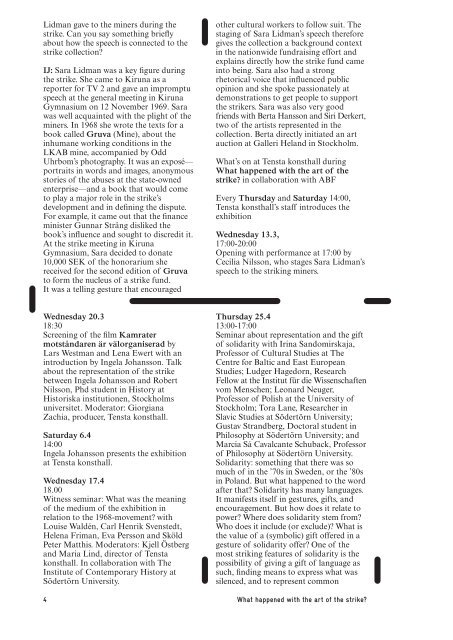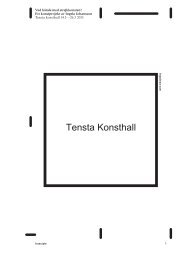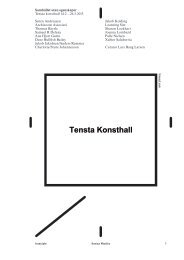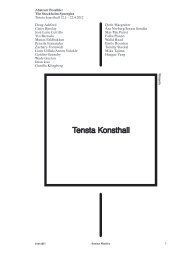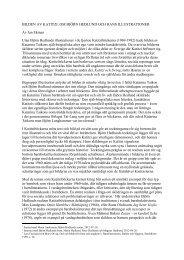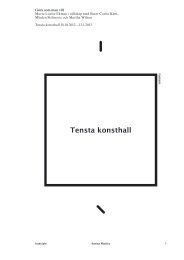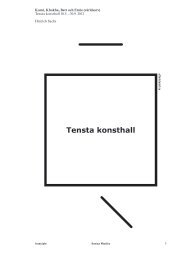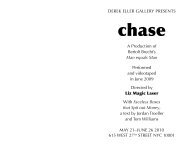What happened with the art of the strike? An art ... - Tensta konsthall
What happened with the art of the strike? An art ... - Tensta konsthall
What happened with the art of the strike? An art ... - Tensta konsthall
Create successful ePaper yourself
Turn your PDF publications into a flip-book with our unique Google optimized e-Paper software.
Lidman gave to <strong>the</strong> miners during <strong>the</strong><br />
<strong>strike</strong>. Can you say something briefly<br />
about how <strong>the</strong> speech is connected to <strong>the</strong><br />
<strong>strike</strong> collection?<br />
IJ: Sara Lidman was a key figure during<br />
<strong>the</strong> <strong>strike</strong>. She came to Kiruna as a<br />
reporter for TV 2 and gave an impromptu<br />
speech at <strong>the</strong> general meeting in Kiruna<br />
Gymnasium on 12 November 1969. Sara<br />
was well acquainted <strong>with</strong> <strong>the</strong> plight <strong>of</strong> <strong>the</strong><br />
miners. In 1968 she wrote <strong>the</strong> texts for a<br />
book called Gruva (Mine), about <strong>the</strong><br />
inhumane working conditions in <strong>the</strong><br />
LKAB mine, accompanied by Odd<br />
Uhrbom’s photography. It was an exposé––<br />
portraits in words and images, anonymous<br />
stories <strong>of</strong> <strong>the</strong> abuses at <strong>the</strong> state-owned<br />
enterprise––and a book that would come<br />
to play a major role in <strong>the</strong> <strong>strike</strong>’s<br />
development and in defining <strong>the</strong> dispute.<br />
For example, it came out that <strong>the</strong> finance<br />
minister Gunnar Sträng disliked <strong>the</strong><br />
book’s influence and sought to discredit it.<br />
At <strong>the</strong> <strong>strike</strong> meeting in Kiruna<br />
Gymnasium, Sara decided to donate<br />
10,000 SEK <strong>of</strong> <strong>the</strong> honorarium she<br />
received for <strong>the</strong> second edition <strong>of</strong> Gruva<br />
to form <strong>the</strong> nucleus <strong>of</strong> a <strong>strike</strong> fund.<br />
It was a telling gesture that encouraged<br />
Wednesday 20.3<br />
18:30<br />
Screening <strong>of</strong> <strong>the</strong> film Kamrater<br />
motståndaren är välorganiserad by<br />
Lars Westman and Lena Ewert <strong>with</strong> an<br />
introduction by Ingela Johansson. Talk<br />
about <strong>the</strong> representation <strong>of</strong> <strong>the</strong> <strong>strike</strong><br />
between Ingela Johansson and Robert<br />
Nilsson, Phd student in History at<br />
Historiska institutionen, Stockholms<br />
universitet. Moderator: Giorgiana<br />
Zachia, producer, <strong>Tensta</strong> <strong>konsthall</strong>.<br />
Saturday 6.4<br />
14:00<br />
Ingela Johansson presents <strong>the</strong> exhibition<br />
at <strong>Tensta</strong> <strong>konsthall</strong>.<br />
Wednesday 17.4<br />
18.00<br />
Witness seminar: <strong>What</strong> was <strong>the</strong> meaning<br />
<strong>of</strong> <strong>the</strong> medium <strong>of</strong> <strong>the</strong> exhibition in<br />
relation to <strong>the</strong> 1968-movement? <strong>with</strong><br />
Louise Waldén, Carl Henrik Svenstedt,<br />
Helena Friman, Eva Persson and Sköld<br />
Peter Matthis. Moderators: Kjell Östberg<br />
and Maria Lind, director <strong>of</strong> <strong>Tensta</strong><br />
<strong>konsthall</strong>. In collaboration <strong>with</strong> The<br />
Institute <strong>of</strong> Contemporary History at<br />
Södertörn University.<br />
4<br />
o<strong>the</strong>r cultural workers to follow suit. The<br />
staging <strong>of</strong> Sara Lidman’s speech <strong>the</strong>refore<br />
gives <strong>the</strong> collection a background context<br />
in <strong>the</strong> nationwide fundraising effort and<br />
explains directly how <strong>the</strong> <strong>strike</strong> fund came<br />
into being. Sara also had a strong<br />
rhetorical voice that influenced public<br />
opinion and she spoke passionately at<br />
demonstrations to get people to support<br />
<strong>the</strong> <strong>strike</strong>rs. Sara was also very good<br />
friends <strong>with</strong> Berta Hansson and Siri Derkert,<br />
two <strong>of</strong> <strong>the</strong> <strong>art</strong>ists represented in <strong>the</strong><br />
collection. Berta directly initiated an <strong>art</strong><br />
auction at Galleri Heland in Stockholm.<br />
<strong>What</strong>’s on at <strong>Tensta</strong> <strong>konsthall</strong> during<br />
<strong>What</strong> <strong>happened</strong> <strong>with</strong> <strong>the</strong> <strong>art</strong> <strong>of</strong> <strong>the</strong><br />
<strong>strike</strong>? in collaboration <strong>with</strong> ABF<br />
Every Thursday and Saturday 14:00,<br />
<strong>Tensta</strong> <strong>konsthall</strong>’s staff introduces <strong>the</strong><br />
exhibition<br />
Wednesday 13.3,<br />
17:00-20:00<br />
Opening <strong>with</strong> performance at 17:00 by<br />
Cecilia Nilsson, who stages Sara Lidman’s<br />
speech to <strong>the</strong> striking miners.<br />
Thursday 25.4<br />
13:00-17:00<br />
Seminar about representation and <strong>the</strong> gift<br />
<strong>of</strong> solidarity <strong>with</strong> Irina Sandomirskaja,<br />
Pr<strong>of</strong>essor <strong>of</strong> Cultural Studies at The<br />
Centre for Baltic and East European<br />
Studies; Ludger Hagedorn, Research<br />
Fellow at <strong>the</strong> Institut für die Wissenschaften<br />
vom Menschen; Leonard Neuger,<br />
Pr<strong>of</strong>essor <strong>of</strong> Polish at <strong>the</strong> University <strong>of</strong><br />
Stockholm; Tora Lane, Researcher in<br />
Slavic Studies at Södertörn University;<br />
Gustav Strandberg, Doctoral student in<br />
Philosophy at Södertörn University; and<br />
Marcia Sá Cavalcante Schuback, Pr<strong>of</strong>essor<br />
<strong>of</strong> Philosophy at Södertörn University.<br />
Solidarity: something that <strong>the</strong>re was so<br />
much <strong>of</strong> in <strong>the</strong> ’70s in Sweden, or <strong>the</strong> ’80s<br />
in Poland. But what <strong>happened</strong> to <strong>the</strong> word<br />
after that? Solidarity has many languages.<br />
It manifests itself in gestures, gifts, and<br />
encouragement. But how does it relate to<br />
power? Where does solidarity stem from?<br />
Who does it include (or exclude)? <strong>What</strong> is<br />
<strong>the</strong> value <strong>of</strong> a (symbolic) gift <strong>of</strong>fered in a<br />
gesture <strong>of</strong> solidarity <strong>of</strong>fer? One <strong>of</strong> <strong>the</strong><br />
most striking features <strong>of</strong> solidarity is <strong>the</strong><br />
possibility <strong>of</strong> giving a gift <strong>of</strong> language as<br />
such, finding means to express what was<br />
silenced, and to represent common<br />
<strong>What</strong> <strong>happened</strong> <strong>with</strong> <strong>the</strong> <strong>art</strong> <strong>of</strong> <strong>the</strong> <strong>strike</strong>?


